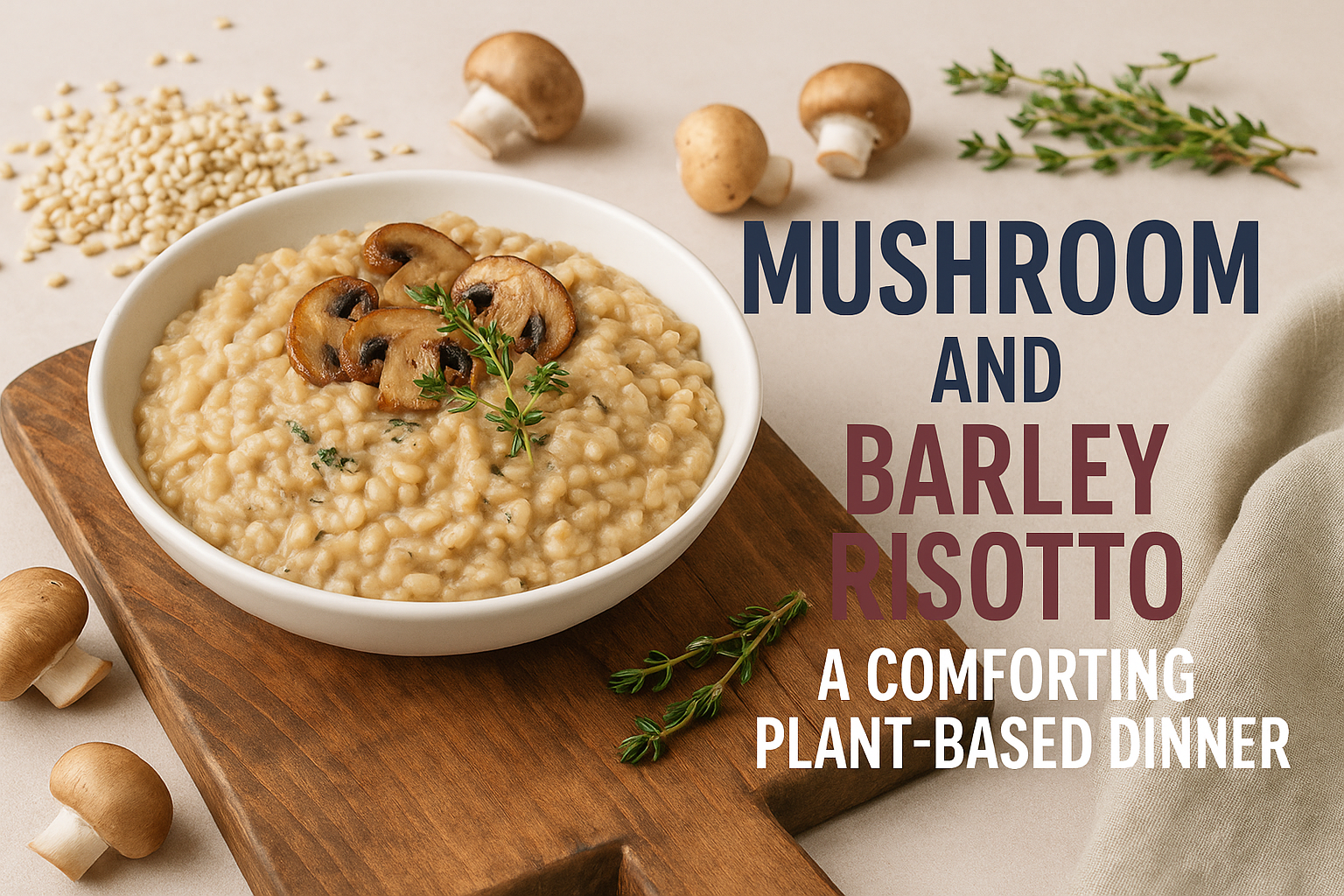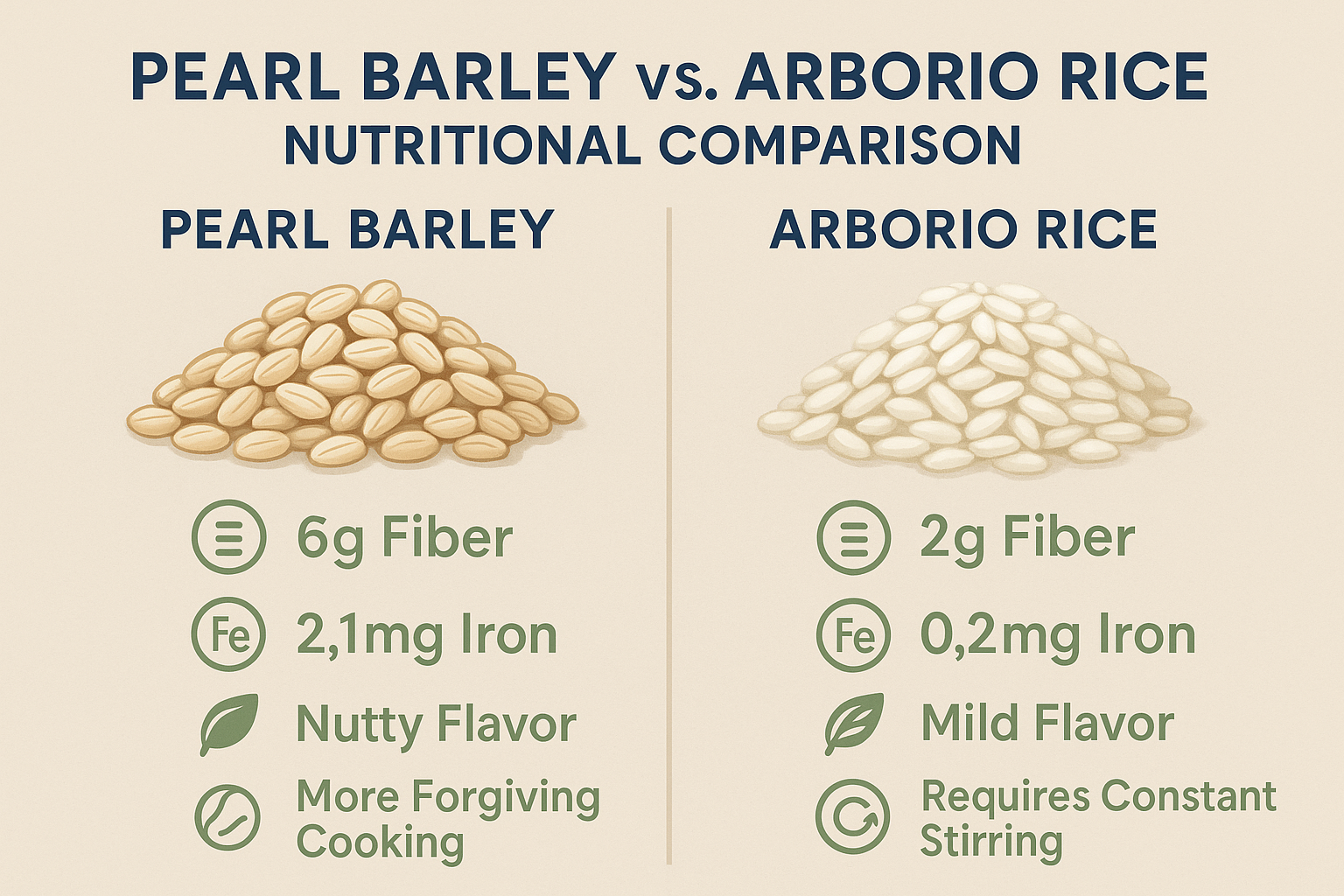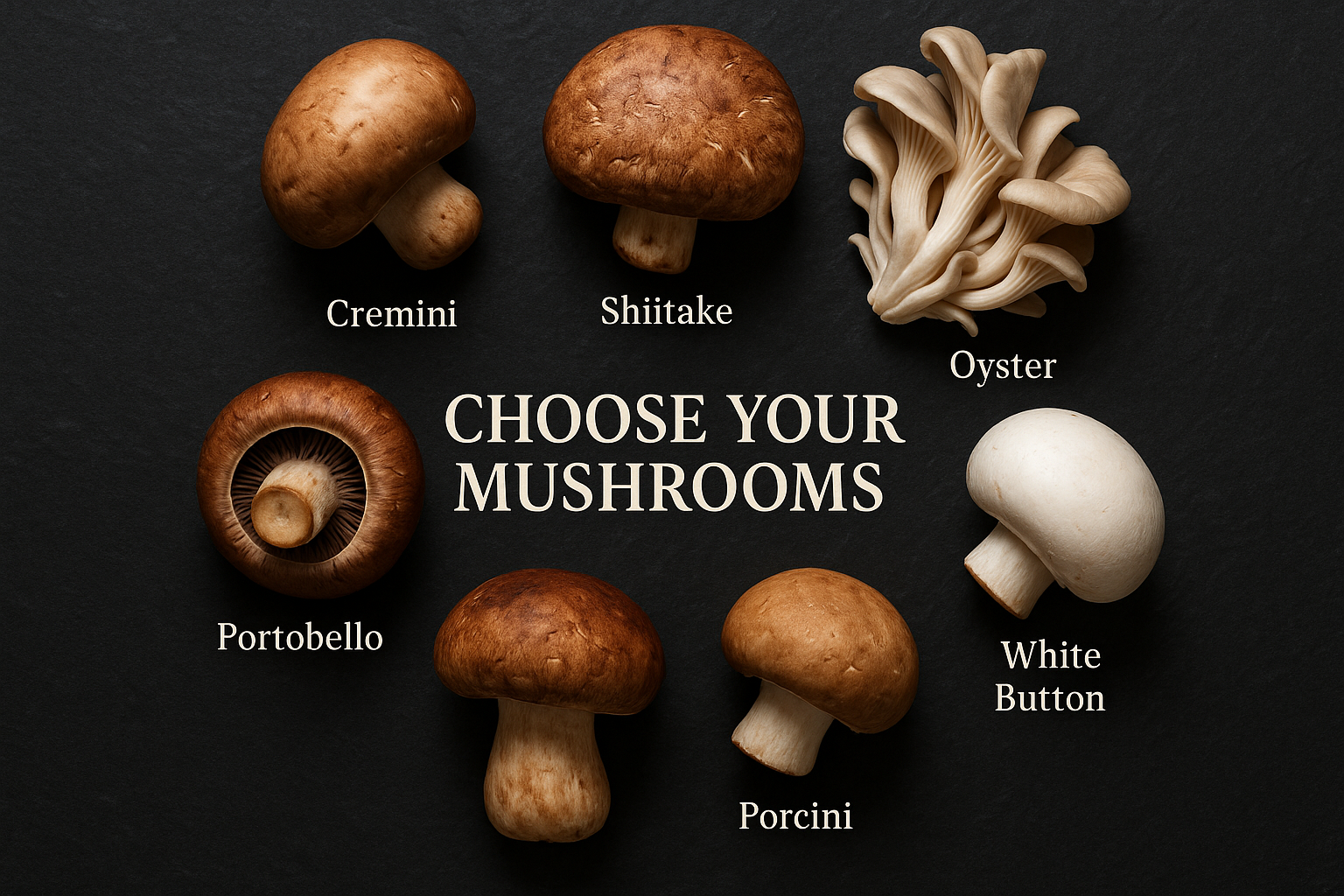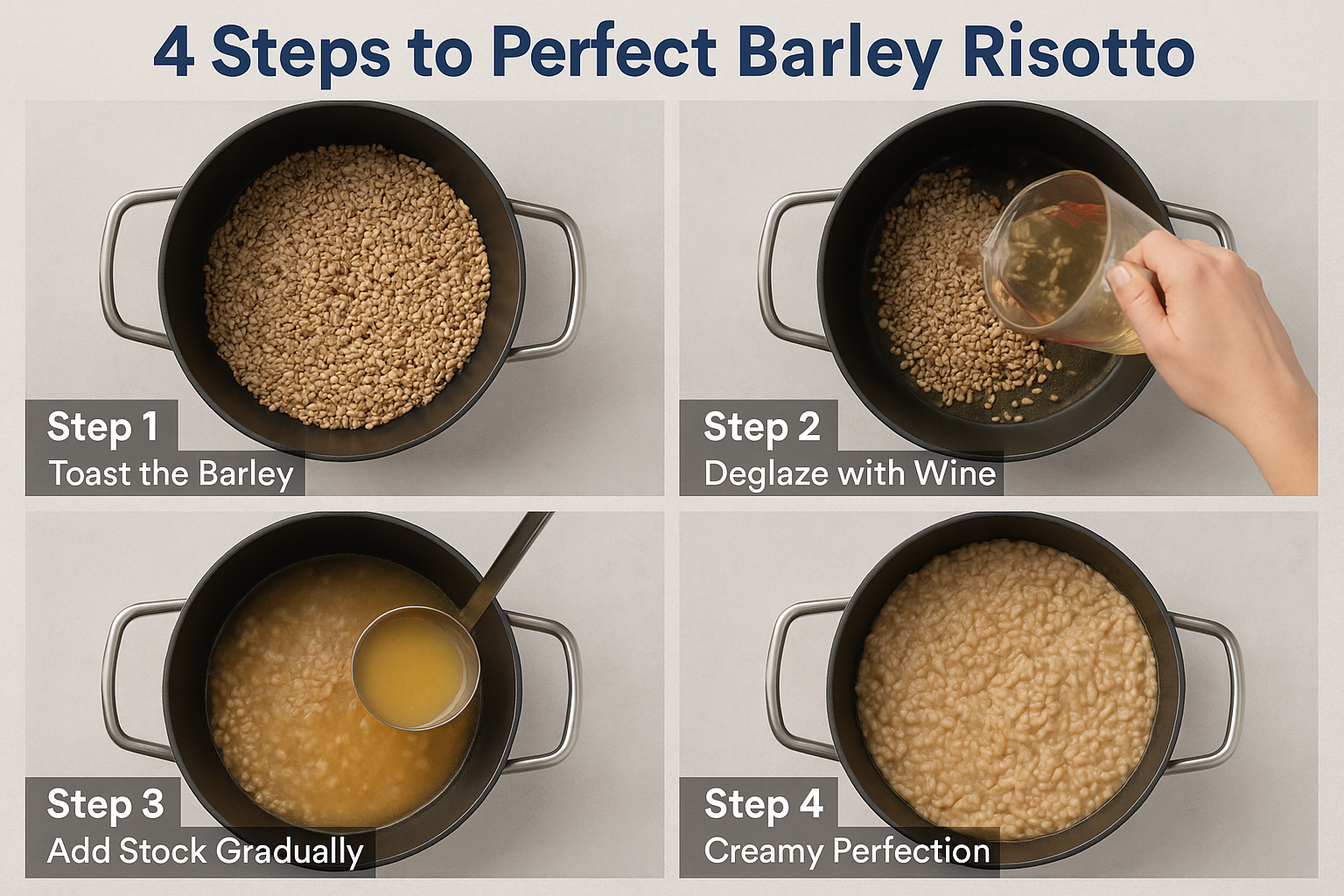Mushroom and Barley Risotto – A Comforting Plant-Based Dinner
Picture this: it’s a chilly evening, and you’re craving something warm, hearty, and utterly satisfying. You want comfort food that doesn’t weigh you down, something that nourishes both body and soul. Enter mushroom and barley risotto—a plant-based twist on the classic Italian dish that delivers all the creamy, savory goodness you’re looking for, with a wholesome, nutty upgrade.
Unlike traditional risotto made with Arborio rice, this version swaps in pearl barley for a heartier texture and impressive nutritional profile. Combined with earthy mushrooms, aromatic herbs, and a splash of white wine, this dish transforms simple ingredients into something truly extraordinary. Whether you’re a seasoned plant-based eater or just looking to add more meatless meals to your rotation, this mushroom and barley risotto will quickly become your go-to comfort dinner.
The best part? While it tastes like you’ve spent hours in the kitchen, it’s surprisingly straightforward to make. No constant stirring required (unlike traditional risotto), and you’ll have a restaurant-quality meal on the table in under an hour. Let’s dive into everything you need to know about creating this cozy, plant-based masterpiece.
Key Takeaways

Why Choose Barley Over Traditional Risotto Rice? 🌾
When most people think of risotto, they immediately picture Arborio rice—those short, starchy grains that release their creaminess when stirred. But barley brings something completely different to the table, and in many ways, it’s an upgrade worth celebrating.
Nutritional Powerhouse
Pearl barley packs a serious nutritional punch that white Arborio rice simply can’t match:
| Nutrient (per 1 cup cooked) | Pearl Barley | Arborio Rice |
|——————————|————–|————–|
| Fiber | 6g | 2g |
| Protein | 3.5g | 3.5g |
| Iron | 2.1mg | 0.2mg |
| Magnesium | 35mg | 10mg |
| Selenium | 13.5mcg | 12mcg |
That fiber content is particularly impressive—barley delivers three times more fiber than white rice, which means better digestion, sustained energy, and improved satiety. You’ll feel satisfied longer without that heavy, sluggish feeling that sometimes follows a carb-heavy meal.
Heartier Texture and Nutty Flavor
Barley has a chewy, substantial texture that holds up beautifully in risotto-style preparations. Each grain maintains its integrity while still releasing enough starch to create that signature creaminess. The nutty, slightly sweet flavor profile complements mushrooms perfectly, creating a more complex taste experience than traditional risotto.
More Forgiving Cooking Process
Here’s a secret that will change your weeknight dinner game: barley risotto doesn’t require the constant stirring that traditional risotto demands. While classic risotto needs nearly continuous attention at the stove, barley is much more forgiving. You can stir occasionally while you prep other ingredients or even do a quick arm toning workout with those dumbbells in the corner—just kidding, but seriously, you’ll have more freedom in the kitchen!
The Magic of Mushrooms: Choosing Your Varieties 🍄
Mushrooms are the star of this dish, providing deep umami flavors and a meaty texture that makes this plant-based meal incredibly satisfying. The key to exceptional mushroom and barley risotto lies in selecting the right varieties and preparing them properly.
Best Mushroom Combinations
Cremini (Baby Bella) Mushrooms
These are your workhorse mushrooms—affordable, readily available, and packed with earthy flavor. They provide a solid base for your risotto and have a firmer texture that holds up well during cooking.
Shiitake Mushrooms
With their distinctive savory taste and slightly chewy texture, shiitakes add complexity and depth. Remove the tough stems before slicing, and save them for homemade vegetable stock.
Oyster Mushrooms
Delicate and slightly sweet, oyster mushrooms bring a tender texture and subtle flavor that balances richer mushroom varieties. They cook quickly, so add them later in the process.
Porcini Mushrooms
Fresh porcini can be expensive and hard to find, but dried porcini mushrooms are a game-changer. Rehydrate them in warm water (save that liquid—it’s liquid gold for your risotto!), and they’ll infuse your dish with intense, woodsy flavors.
Preparation Tips for Maximum Flavor
Don’t wash, just brush: Mushrooms are like sponges. Instead of rinsing them under water, use a damp paper towel or mushroom brush to remove any dirt. This prevents them from becoming waterlogged and ensures better browning.
Slice consistently: Cut your mushrooms into similar-sized pieces (about ¼-inch thick) so they cook evenly. This attention to detail makes a noticeable difference in the final dish.
Brown them properly: This is crucial! Cook mushrooms in batches over medium-high heat without crowding the pan. When mushrooms have space, they’ll develop beautiful golden-brown edges that add incredible depth to your risotto. Crowded mushrooms steam instead of sear, resulting in a less flavorful dish.
Essential Ingredients for Perfect Mushroom and Barley Risotto

Creating restaurant-quality risotto at home starts with gathering the right ingredients. Here’s what you’ll need to build layers of flavor in this comforting plant-based dinner.
The Foundation
Pearl Barley (1½ cups)
Look for pearl barley rather than hulled barley—it cooks faster and creates a creamier texture. Hulled barley is more nutritious but takes significantly longer to cook and won’t achieve the same creamy consistency.
Mixed Mushrooms (1 pound)
As discussed above, a combination of varieties works best. Try 8 ounces cremini, 4 ounces shiitake, and 4 ounces oyster mushrooms, plus 1 ounce dried porcini.
Vegetable Stock (6-7 cups)
Use high-quality vegetable stock—it makes a difference! If using store-bought, choose low-sodium options so you can control the salt level. Keep it warm on the stove in a separate pot.
Aromatics and Flavor Builders
The Flavor Enhancers
Dry White Wine (¾ cup)
A crisp Sauvignon Blanc or Pinot Grigio works beautifully. The acidity brightens the dish and adds sophistication. If avoiding alcohol, substitute with additional vegetable stock plus a tablespoon of white wine vinegar or lemon juice.
Nutritional Yeast (¼ cup)
This is the secret weapon for plant-based creaminess and a subtle cheesy flavor without any dairy. It also adds B vitamins and protein.
Extra Virgin Olive Oil (3-4 tablespoons)
For sautéing and finishing. Choose a good quality oil—you’ll taste the difference.
Fresh Lemon Juice (from 1 lemon)
Added at the end to brighten all the flavors and cut through the richness.
Step-by-Step Guide to Making Mushroom and Barley Risotto
Now that we’ve covered the why and the what, let’s get to the how. This recipe serves 4-6 people and takes approximately 50-60 minutes from start to finish.
Step 1: Prepare Your Mise en Place
Professional chefs swear by mise en place—having everything prepped and ready before you start cooking. This makes the actual cooking process smooth and stress-free.
“The secret to great cooking isn’t complicated techniques—it’s proper preparation and quality ingredients working in harmony.”
Step 2: Build Your Flavor Base
Heat 2 tablespoons of olive oil in a large, heavy-bottomed pot or Dutch oven over medium heat. Add the diced onion and cook for 5-7 minutes until soft and translucent. You’re not looking for browning here—just gentle softening that brings out the natural sweetness.
Add the minced garlic and cook for another minute until fragrant. Be careful not to burn it; burnt garlic tastes bitter and will ruin your dish.
Step 3: Toast the Barley
Add the pearl barley to the pot and stir to coat every grain with the oil and aromatics. Toast the barley for 2-3 minutes, stirring frequently. You’ll notice it starts to smell slightly nutty—that’s exactly what you want. This toasting step enhances the barley’s natural flavor and helps each grain maintain its texture.
Step 4: Deglaze with Wine
Pour in the white wine and stir, scraping up any browned bits from the bottom of the pot. Let the wine simmer until it’s mostly absorbed, about 2-3 minutes. The alcohol will cook off, leaving behind bright, complex flavors.
Step 5: Begin Adding Stock
Now comes the risotto method, but remember—barley is more forgiving than rice! Add the warm vegetable stock one ladle at a time (about ¾ cup), stirring occasionally. You don’t need to stir constantly like traditional risotto.
Wait until each addition is mostly absorbed before adding the next ladle. This gradual addition allows the barley to release its starches slowly, creating that creamy texture we’re after.
Add the bay leaves, thyme sprigs, and rosemary sprig after the first addition of stock. Also add the chopped rehydrated porcini mushrooms and their soaking liquid (strain it through a coffee filter to remove any grit).
Continue this process for about 35-40 minutes. The barley should be tender but still have a pleasant chew—al dente, as the Italians say.
Step 6: Sear the Fresh Mushrooms
While the barley is cooking, heat a large skillet over medium-high heat. Add 1 tablespoon of olive oil and half of your sliced fresh mushrooms. This is where you can engage those dumbbell shoulder exercises you’ve been practicing—just kidding! But seriously, resist the urge to stir constantly.
Let the mushrooms sit undisturbed for 3-4 minutes to develop that beautiful golden crust. Then stir and cook for another 2-3 minutes. Season with salt and pepper, then transfer to a plate. Repeat with the remaining mushrooms.
Step 7: Bring It All Together
When the barley is tender and creamy, remove the bay leaves, thyme stems, and rosemary sprig. Stir in most of the seared mushrooms (reserve some for garnish), the nutritional yeast, and an extra tablespoon of olive oil.
Taste and adjust seasoning with salt and freshly ground black pepper. Stir in the fresh lemon juice—this final bright note ties everything together beautifully.
Step 8: Rest and Serve
Remove the pot from heat and let it rest for 5 minutes. This allows the flavors to meld and the texture to settle into perfect creaminess. If it seems too thick, stir in a bit more warm stock.
Serve in shallow bowls, topped with the reserved seared mushrooms, a drizzle of good olive oil, fresh thyme leaves, and a crack of black pepper. Some people also love adding a sprinkle of nutritional yeast or vegan parmesan on top.
Nutritional Benefits That Go Beyond Comfort 💪
This mushroom and barley risotto isn’t just comfort food—it’s genuinely nourishing. Let’s break down why this plant-based dinner deserves a regular spot in your meal rotation.
Complete Nutrition in One Bowl
Each serving delivers approximately:
Blood Sugar Friendly
The high fiber content in barley means this dish has a lower glycemic index than traditional white rice risotto. Your blood sugar won’t spike and crash, which means sustained energy without the afternoon slump. This makes it an excellent choice for anyone managing blood sugar levels or simply wanting to avoid energy crashes.
Heart-Healthy Profile
Barley contains beta-glucan, a type of soluble fiber that’s been shown to help lower cholesterol levels. Combined with the zero cholesterol and low saturated fat from this plant-based preparation, you’ve got a truly heart-healthy meal that doesn’t sacrifice flavor.
Immune System Support
Mushrooms are nutritional powerhouses often overlooked. They contain:
Think of this dish as fuel for your body—the kind that supports everything from your upper body strength training sessions to your mental clarity throughout the day.
Creative Variations and Customizations 🎨

One of the beautiful things about mushroom and barley risotto is its versatility. Once you’ve mastered the basic recipe, you can customize it endlessly to suit your tastes, dietary needs, or what’s in season.
Seasonal Vegetable Additions
Spring Version: Stir in fresh asparagus tips, peas, and baby spinach during the last 5 minutes of cooking. Finish with fresh mint and lemon zest for a bright, spring-forward dish.
Summer Version: Add diced zucchini, yellow squash, and fresh corn kernels. Top with fresh basil and cherry tomatoes for a garden-fresh experience.
Fall Version: Incorporate diced butternut squash (roasted separately) and crispy fried sage leaves. A pinch of nutmeg adds warmth.
Winter Version: Stir in chopped kale or Swiss chard, roasted Brussels sprouts, and a touch of truffle oil for ultimate cold-weather comfort.
Protein Boosts
While this dish is satisfying on its own, you can easily increase the protein content:
Flavor Variations
Mediterranean Style: Add sun-dried tomatoes, kalamata olives, capers, and fresh oregano. Finish with a squeeze of lemon and fresh parsley.
Asian-Inspired: Use shiitake mushrooms exclusively, add fresh ginger with the garlic, swap thyme for fresh cilantro, and finish with a drizzle of toasted sesame oil and sliced scallions.
Smoky Version: Add smoked paprika and a chipotle pepper in adobo sauce (minced) for a subtle smoky heat that’s absolutely addictive.
Herb Garden: Go heavy on fresh herbs—add fresh parsley, chives, tarragon, and chervil just before serving for an explosion of fresh flavor.
Make-Ahead and Storage Tips 📦
Life gets busy, and having strategies for meal prep can make the difference between eating well and reaching for takeout. The good news? Mushroom and barley risotto is incredibly make-ahead friendly.
Meal Prep Strategy
Full Make-Ahead: Cook the entire recipe through step 7, but slightly undercook the barley (it should still have a firm bite). Let it cool completely, then store in airtight containers in the refrigerator for up to 4 days. When ready to serve, reheat gently on the stovetop with a splash of vegetable stock, stirring until heated through and creamy.
Partial Prep: Prep all your ingredients—dice onions, slice mushrooms, measure out barley and stock—and store them separately in the refrigerator. When you’re ready to cook, you’ll have everything ready to go, cutting your active cooking time significantly.
Mushroom Prep: Sear your mushrooms up to 2 days in advance. Store them separately and add them when reheating the risotto to maintain their texture.
Storage Guidelines
Refrigerator: Store cooled risotto in airtight containers for up to 4-5 days. The barley will continue to absorb liquid as it sits, so you’ll need to add stock or water when reheating.
Freezer: While the texture changes slightly, you can freeze this risotto for up to 3 months. Portion it into individual servings in freezer-safe containers. Thaw overnight in the refrigerator before reheating. Add extra liquid and stir frequently while reheating to restore creaminess.
Reheating Tips: Always reheat on the stovetop rather than the microwave when possible. Add ¼ to ½ cup of vegetable stock and heat over medium-low heat, stirring frequently. The microwave works in a pinch—just add liquid, cover, and stir halfway through heating.
Perfect Pairings: What to Serve Alongside 🍷
While mushroom and barley risotto is substantial enough to stand alone as a complete meal, certain accompaniments can elevate your dining experience.
Salad Pairings
Arugula Salad with Lemon Vinaigrette: The peppery bite of arugula and bright acidity of lemon cut through the richness of the risotto beautifully. Toss with shaved fennel, toasted walnuts, and a simple lemon-olive oil dressing.
Roasted Beet and Citrus Salad: Sweet roasted beets, segmented oranges, and fresh mint create a colorful, refreshing contrast. The earthiness of beets complements the mushrooms perfectly.
Simple Green Salad: Sometimes simple is best. Mixed greens with a light balsamic vinaigrette and some shaved radishes provide textural contrast and freshness.
Vegetable Sides
Roasted Broccolini: Charred broccolini with garlic and red pepper flakes adds a slightly bitter, spicy element that balances the creamy risotto.
Glazed Carrots: Roasted carrots with a maple-balsamic glaze bring sweetness and vibrant color to your plate.
Sautéed Greens: Simple garlicky Swiss chard, kale, or spinach adds nutrition and a slight bitterness that complements the dish.
Bread Options
Crusty Sourdough: There’s something deeply satisfying about mopping up creamy risotto with a piece of crusty bread. Toast it lightly and rub with a garlic clove for extra flavor.
Garlic Bread: Classic for a reason. Make it plant-based with olive oil, minced garlic, and fresh parsley.
Focaccia: Rosemary focaccia pairs beautifully with the herbal notes in the risotto.
Beverage Pairings
White Wine: The same crisp white wine you used in cooking—Sauvignon Blanc or Pinot Grigio—makes an excellent pairing. The acidity complements the richness without overwhelming the delicate flavors.
Light Red Wine: A Pinot Noir with its earthy notes and bright acidity works surprisingly well with mushroom dishes.
Non-Alcoholic Options: Sparkling water with lemon, herbal tea, or a crisp apple cider all work beautifully.
Common Mistakes to Avoid ⚠️

Even experienced cooks can stumble when making risotto-style dishes. Here are the most common pitfalls and how to avoid them.
Using Cold Stock
The Mistake: Adding cold stock to your risotto causes the temperature to drop dramatically with each addition, slowing down the cooking process and preventing proper starch release.
The Fix: Always keep your vegetable stock warm in a separate pot on the stove. This maintains consistent cooking temperature and ensures creamy results.
Overcrowding the Mushrooms
The Mistake: Dumping all your mushrooms into the pan at once creates steam instead of sear, resulting in pale, rubbery mushrooms without that delicious caramelization.
The Fix: Cook mushrooms in batches with plenty of space between them. Patience here pays off in flavor.
Not Tasting as You Go
The Mistake: Waiting until the end to season means you’ve missed opportunities to build layers of flavor throughout the cooking process.
The Fix: Taste your risotto at different stages. Adjust seasoning gradually, remembering that flavors concentrate as liquids reduce.
Rushing the Process
The Mistake: Trying to speed things up by adding all the stock at once or cranking up the heat results in unevenly cooked barley—crunchy in some spots, mushy in others.
The Fix: Embrace the process. The gradual addition of stock isn’t just tradition—it’s technique. Put on some music, pour yourself a glass of wine, and enjoy the meditative rhythm of making risotto.
Skipping the Rest Period
The Mistake: Serving immediately after the last addition of stock doesn’t give the dish time to settle into its final creamy texture.
The Fix: Let the risotto rest off the heat for 5 minutes before serving. This allows residual heat to finish cooking, flavors to meld, and texture to perfect itself.
Frequently Asked Questions
Can I use hulled barley instead of pearl barley?
Yes, but be prepared for significantly longer cooking time (60-75 minutes instead of 35-40 minutes) and a chewier texture. Hulled barley retains more of the outer bran layer, making it more nutritious but less creamy.
Is this recipe gluten-free?
No, barley contains gluten. For a gluten-free version, substitute with brown rice, wild rice blend, or quinoa, though the texture and cooking time will differ.
Can I make this in an Instant Pot or pressure cooker?
Absolutely! Sauté the aromatics and toast the barley using the sauté function, then add all the stock at once with the mushrooms and herbs. Cook on high pressure for 20 minutes, then natural release for 10 minutes. Stir in nutritional yeast and lemon juice before serving.
How can I make this oil-free?
Sauté the aromatics in a few tablespoons of vegetable stock instead of olive oil. For the mushrooms, use a non-stick pan and dry-sear them, or roast them in the oven at 400°F until golden.
What if I don’t have nutritional yeast?
You can substitute with vegan parmesan, though the flavor will be slightly different. For a completely different approach, stir in a tablespoon of white miso paste for umami depth and creaminess.
The Perfect Weeknight Comfort Meal
There’s something magical about a dish that manages to be both sophisticated and comforting, nutritious and indulgent, simple and impressive. Mushroom and barley risotto checks all these boxes and then some.
In a world where we’re constantly rushing—squeezing in arm toning workouts before work, mastering dumbbell shoulder exercises during lunch breaks, building upper body strength whenever we can—it’s important to have meals that nourish us completely. This risotto does exactly that. It fuels your body with whole grains, vegetables, and plant-based nutrition while satisfying your soul with rich, comforting flavors.
The beauty of this recipe lies not just in its delicious results, but in the process itself. Making risotto can be meditative—the rhythmic stirring, the gradual transformation of simple ingredients into something greater than the sum of their parts, the warm, earthy aromas filling your kitchen. It’s an opportunity to slow down, even on a busy weeknight.
Whether you’re cooking for yourself, your family, or hosting friends, this mushroom and barley risotto delivers. It’s elegant enough for company yet simple enough for a Tuesday dinner. It’s hearty enough to satisfy the biggest appetites yet light enough that you won’t feel weighed down afterward.
Conclusion: Your New Go-To Plant-Based Comfort Dish
Mushroom and barley risotto represents everything we want from modern comfort food in 2025. It’s plant-based without being preachy, nutritious without sacrificing flavor, and sophisticated without being complicated. This dish proves that eating well doesn’t mean choosing between health and happiness—you can have both in one creamy, satisfying bowl.
The versatility of this recipe means it will never get boring. Change up the mushroom varieties, experiment with seasonal vegetables, adjust the herbs to match your mood. Each variation teaches you something new about building flavors and working with whole grains.
Your Action Plan
Ready to make this dish your own? Here’s what to do next:
Remember, cooking is a journey, not a destination. Each time you make this risotto, you’ll get more comfortable with the technique, more confident in your adjustments, and more connected to the simple pleasure of creating something delicious from scratch.
So grab your pearl barley, hunt down some beautiful mushrooms, and get ready to create a bowl of pure comfort. Your kitchen is about to smell absolutely amazing, and your dinner table is about to get a whole lot cozier. Happy cooking! 🍄✨
—
SEO Meta Title and Description
Meta Title: Mushroom Barley Risotto Recipe | Plant-Based Dinner 2025
Meta Description: Discover the ultimate mushroom and barley risotto recipe. This comforting plant-based dinner is creamy, nutritious, and easier than traditional risotto.
—




